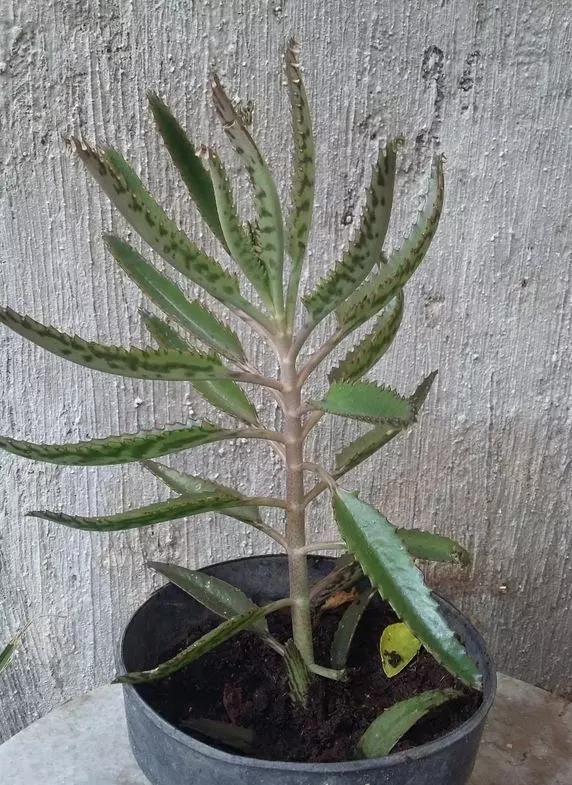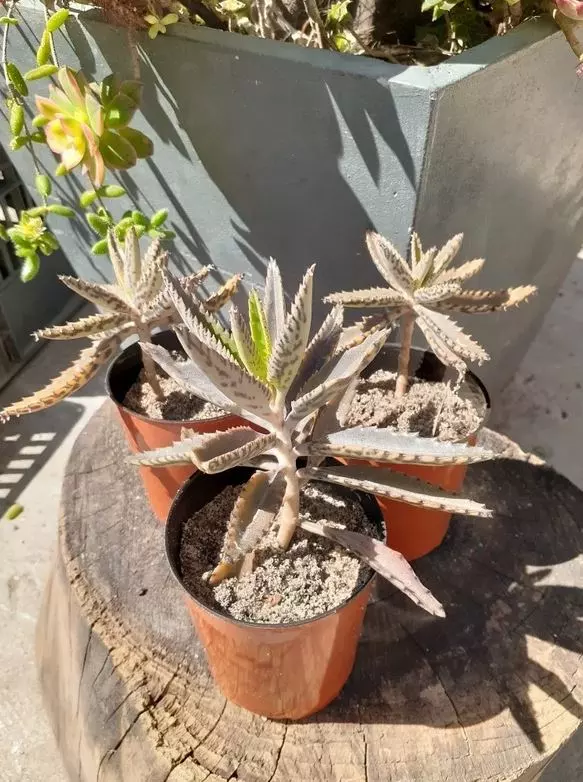Its common name as the kalanchoe daigremontiana plant is known as mother of thousands or devil’s thorn. It is probably due to the way it unfolds its leaves and how new stems emerge from it, forming a characteristic arrangement related to a skeleton. Learn all about mother of thousands succulent in this article.
This characteristic plant has a series of cares that we are going to tell you rigorously. As a curiosity to tell you that we can grow mother of thousands succulent both indoors and outdoors, arranged in pots, so we have many options to have it at home or on the terrace.
Table of Contents
Characteristic Data of Kalanchoe daigremontiana
Family: Crassulaceae (Crassulaceae)
Subfamily: Kalanchoideae
Genus: Kalanchoe
As for its development, it rarely exceeds one meter in height if grown in pots. Like almost all crassulaceae, its root development is limited and it obtains much of the water it needs from the ambient humidity.
A curiosity of Kalanchoe daigremontiana is its ability to form new shoots from its leaves, something that characterizes this plant and that gives it the value it currently has for its cultivation.
Its flowering occurs when it feels like it. It is an anecdotal fact that today surprises the scientific community and there is no reason why. The a priori conditions for its flowering are not always met or it does not flower during its life cycle.
Keys to Mother of Thousands Succulent Cultivation
Weather
Being a member of the Crassulaceae family (Crassulaceae), it offers excellent conditions for adapting to different climates. Therefore, it can be cultivated as an indoor and outdoor plant.

Temperature
Its cultivation should be avoided in particularly cold or shady areas, as it needs a temperature range for its development higher than 50°F (10 ºC), the optimum being between 64.4°F and 82.4°F (18 ºC and 28 ºC).
Lighting Mother of Thousands
If we cultivate any variety of Kalanchoe, we will always look for its disposition in full sun and without any obstacle of the light entrance.
Humidity Mother of Thousands
Its leaves and stems can store moisture very well inside. Except in particularly dry areas, it will not be necessary to make foliar sprays and only the humidity of the substrate will be enough.
Soil Characteristics for Mother of Thousands
Mother of Thousands Succulent in the Garden
The options for modifying the medium in the soil are much more limited than in pot culture. Before planting Kalanchoe daigremontiana, we will seek to aerate the soil by turning it at least the first 12” (30 cm). We will incorporate a layer of organic matter and stir it with the soil.
In this way, we will improve the moisture retention capacity but without causing waterlogging that affects root development.
Therefore, avoid heavy and clayey soils as the absorbent root hairs of Kalanchoe daigremontiana are very sensitive. Look for a soil texture that is a mixture of loamy and sandy.
Mother of Thousands Succulent in Pots
When preparing the substrate for pot culture, we can opt for a commercial substrate mix (peat) that may contain some sand. What we need is sufficient drainage capacity to avoid waterlogging and limit the oxygenation of its roots, which are already somewhat poor.
It is important that the container or pot where we cultivate it has enough diameter, minimum 12” (30 cm), and more than 8” (20 cm) deep. At the bottom, we will place gravel of medium size to promote drainage, with enough holes in the bottom to allow the free exit of irrigation water.
Between the dish and the pot, we will be able to place stones or flat objects that offer a separation between both parts. In this way, we will avoid the rise of water by capillarity and the rotting of roots.

Watering and Fertilization Mother of Thousands
One of the worst enemies of crassulaceae and specifically of mother of thousands is overwatering. We make the mistake of treating it as if it belonged to another family and on most occasions, we lead to the complete rotting of the plant.
This plant has great resistance to salinity and a great capacity to take advantage of the environmental humidity and the morning dew. Therefore, irrigation needs to be very limited.
By this, we mean that with high temperatures, in the summer season, we will water a maximum of once a week. In winter, with higher environmental humidity, we will not water except for temperature spikes.
With 0.26 gallon (1 liter) per irrigation and a plant of more than 16 ft (0.5 m) in height will be enough to favor its growth and the assimilation of a good part of the water.
As for the fertilization, with the increase of temperatures, we will observe an elongation of the stems and the exit of new buds on the leaves. At this time, it may be advisable to use gradual release fertilizers in the form of granules or liquids that can be added to the irrigation water.

Propagation Mother of Thousands Succulent
Because of the shape and appearance of its leaves, it is easy to reproduce mother of thousands succulent.
The plant can multiply from its leaves, which have to be planted in the moist substrate so that they emit new roots and form a new plant.
The easiest system of reproduction is to color several leaves on a continuously moist substrate. In a few days, we will see the formation of new leaves on their axillary buds.
As the stems come out and with great care, we remove them from the leaf and plant them in the same substrate. With this simple operation, we will be able to obtain many plants from a previous leaf, identically exact to the mother.


